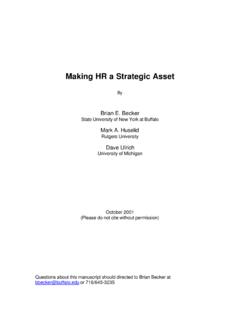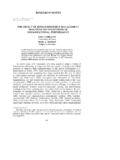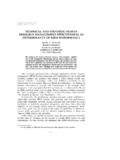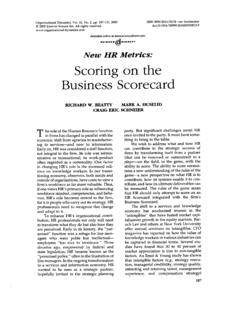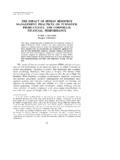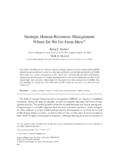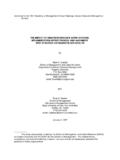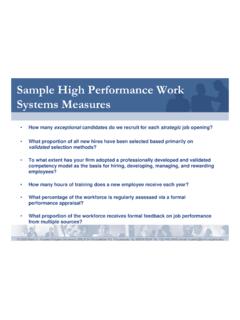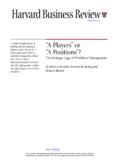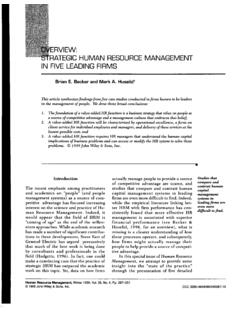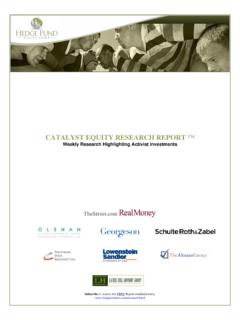Transcription of Value Creation Through Strategy Implementation: The …
1 Under Review, Academy of Management Review. Value Creation Through Strategy implementation : The Black-Box in SHRM Theory Brian E. Becker Professor of Human Resources School of Management 280A Jacobs Management Center State University of New York at Buffalo Buffalo, NY 14260 716-645-3235 And Mark A. Huselid Associate Professor of Human Resources School of Management and Labor Relations Rutgers The State University of New Jersey 94 Rockafeller Road, Rm. 216 Piscataway, NJ 08854 732-445-5445 April 2003 Not for citation or attribution without permission. The authors would like to thank Susan Jackson for her helpful comments on an earlier version of this paper. Questions and comments about the paper should be sent to Brian Becker at 2 Value Creation Through Strategy implementation : The Black-Box in SHRM Theory Abstract This paper argues that prior theoretical work on the topic of strategic human resource management (SHRM) has not fully elaborated the link between a firm s HR architecture - or overall system of human capital management - and its subsequent financial performance.
2 Drawing on the Strategy literature we propose explicitly including effective Strategy implementation as the key mediating variable in this relationship. This also requires a new focus on the idiosyncratic dimension of HR s strategic fit. These extensions of SHRM theory more completely articulate the HR s impact on Value Creation by increasing the inimitability of the HR architecture s influence on firm performance. 3 Value Creation Through Strategy implementation : The Black-Box in SHRM Theory For more than a decade academic research as well as management practice has increasingly focused on intangible assets as sources of Value Creation . Attributes such as brand Value , research and development, and customer relationships have become widely recognized for their long-run financial Value (Lev, 2001).
3 Likewise managers and scholars have increasingly included human capital, and the human resource management systems that produce it, among the intangible assets that potentially have strategic Value (Becker and Gerhart, 1996). Within the organizational sciences, the strategic human resources management (SHRM) literature has focused on the relationship between human capital, human resource management systems, and firm performance. While the SHRM literature has developed a rich body of empirical results at different levels of analysis (see Delery & Shaw, 2001 for a review), the underlying theoretical framework has not developed at the same pace (McMahan, Virick, & Wright, 1999). The notion of human resources as a strategic asset is a significant change in perspective for a field where the focus on performance has traditionally has been at the micro level.
4 The domain of Strategy in contrast involves more macro level phenomena where Value Creation and superior financial performance are ultimately based on sustainable competitive advantage (Barney, 2002; Schendel, 1996). This poses a special challenge for SHRM theory as it seeks to integrate these two literatures. As an interdisciplinary theory, SHRM theory draws on the human resource management (HRM) literature to explain what HR practices and systems produce potentially valuable human capital, but then must rely on the Strategy literature to explain why that human capital can be a source of Value Creation . What s missing in SHRM theory is the how. In short, any strategic human resources theory must have at its core a clearly articulated mechanism by which an organization s human resources are a source of sustained competitive 4advantage.
5 According to Becker and Gerhart (1996), our understanding of this black box remains a significant gap in the SHRM literature. They concluded (p. 793): Unless and until researchers are able to elaborate and test more complete structural models for example, models including key intervening variables it will be difficult to rule out alternative causal models that explain observed associations between HR systems and firm performance. Instead, HR scholars have tended to focus on a further elaboration of the HR architecture - or overall system of human capital management; namely what HR practices and systems produce potentially valuable human capital ( , Delery and Doty, 1996; Huselid, 1995; Wright and Snell, 1998).
6 Empirical research has examined various elements of the HR architecture with attention to role behaviors (Schuler and Jackson, 1995), employee commitment and involvement (Batt, 2002), and high performance work systems (Huselid, 1995; MacDuffie, 1995; Youndt, Snell, Dean, & Lepak, 1996). This research has generated a set of empirical results that are consistent with the theoretical implications of the Strategy literature, but do not follow from an SHRM theory that directly integrates that theoretical literature. As Barney (2001) observes, the Strategy literature simply provides a theoretical context for examining the implications of HR for firm performance. With a few exceptions (Becker and Huselid, 1998; Wright, Dunford, & Snell, 2001) there has been little effort to extend SHRM theory in a way that formally integrates the mechanism by which the HR architecture actually influences firm performance.
7 We address this theoretical gap in the SHRM literature in two ways. First, we propose a theoretical model for SHRM that formalizes the widely held view that HR s strategic impact occurs Through the process of Strategy implementation (Becker and Huselid, 1998; Schuler and Jackson, 1987; Wright and Snell, 1998). Our approach extends SHRM theory by explicitly incorporating effective Strategy implementation as the mechanism Through which 5HR contributes to new Value Creation . While the prior SHRM literature expressly mentions Strategy implementation as the source of HR s impact on firm performance, the nature of that theoretical relationship has never been clearly articulated. Strategy implementation has implicitly been treated as the result of an appropriate match between the HR architecture and the firm s competitive Strategy , rather than an independent theoretical construct.
8 We argue that the HR-firm performance link is not as direct as suggested by the prior literature. Instead intermediate outcomes, as part of an indirect link, are central to a more complete understanding of how the HR architecture can be a source of new Value Creation (Becker and Gerhart, 1996). This extension of SHRM theory complements recent work in the Strategy literature (Barney, 2001; Porter, 1996) that emphasizes the nature and contribution of Strategy execution as source of competitive advantage. Incorporating effective Strategy implementation as the central intervening variable in SHRM theory is only the first step in removing the theoretical black box in the HR architecture firm performance relationship.
9 Despite considerable attention at both the conceptual and empirical levels, the nature and role of fit in the SHRM literature needs further theoretical elaboration as well, because the how of HR s strategic potential turns on HR s strategic fit. While the SHRM literature has always acknowledged the importance of an HR- Strategy fit (Schuler and Jackson, 1987; Wright and Snell, 1998), the nature of that fit implies a generic relationship between the HR and the larger competitive Strategy . Irrespective of the strategic framework being used (Miles and Snow, 1994; Porter, 1985) there are typically three or four competitive strategies available to the firm. We use the term generic relationships because the logic implies that there is an appropriate HR architecture for each of these competitive strategies.
10 For example, an HR focus on rewarding outcomes rather than procedures is suggested as an 6appropriate fit with a Prospector (innovation) Strategy (Miles and Snow, 1994). Similarly role behaviors that emphasized risktaking were deemed an appropriate fit with an innovation Strategy (Jackson and Schuler, 1995). Since there are only a limited number of competitive Strategy types, there are a limited number of appropriate HR architectures. This notion of strategic fit, however, limits the uniqueness of HR architectures across firms, makes them easier to imitate, and reduces their Value as sustainable sources of competitive advantage. The empirical evidence bears this out. Despite a general consensus that fit ought to play a central role in SHRM theory, empirical tests of this generic HR-competitive Strategy contingency have provided little support for a fit hypothesis (Becker and Gerhart, 1996; Becker and Huselid, 1998; Delery and Doty, 1996; Huselid, 1995).
